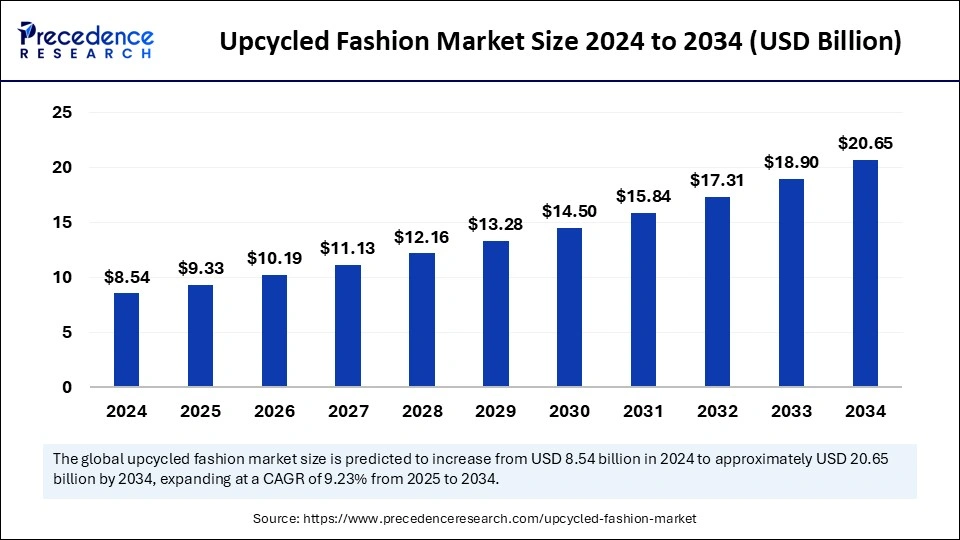Upcycled Fashion Market Set for USD 20.65 Bn Growth by 2034
Upcycled fashion market is expected to reach USD 20.65 billion by 2034, up from USD 8.54 billion in 2024,Growing at a CAGR of 9.23%

- Europe led the market with the largest share of 36% in 2024.
- Asia Pacific is expected to expand at the highest CAGR between 2025 and 2034.
- By type, the apparel segment held the biggest market share of 69% in 2024.
- By type, the accessories segment is anticipated to witness the fastest growth during the forecast period.
- By end-use, the women segment captured the largest market share in 2024.
- By end-use, the men segment is expected to expand at the highest CAGR over the projection period.
- By distribution channel, the offline segment dominated the market in 2024.
- By distribution channel, the online is expected to be the fastest-growing segment in the coming years.
Upcycled Fashion Market Overview
The upcycled fashion market is transforming the global fashion landscape by redefining waste management practices and promoting sustainable consumption. Upcycled fashion involves repurposing discarded materials, textiles, and garments into high-quality, unique fashion items that minimize environmental impact. This trend is part of the broader shift towards a circular economy, where waste is viewed as a valuable resource rather than a disposable byproduct. Increasing awareness of the fashion industry’s environmental footprint, coupled with growing consumer preferences for ethical and sustainable products, is driving the expansion of the upcycled fashion market.
Leading fashion brands are incorporating upcycling practices into their design and production processes, while independent designers and niche brands are innovating with creative upcycling techniques to craft one-of-a-kind garments. Moreover, government policies promoting waste reduction and recycling are supporting the adoption of sustainable practices in the fashion industry. As the market continues to evolve, the integration of technology, transparency, and traceability will play a pivotal role in enhancing the scalability and credibility of upcycled fashion products.
Market Drivers
Shifting Consumer Preferences Toward Sustainable Consumption: Increasing consumer awareness of environmental issues is driving demand for fashion products that align with sustainable values.
Government Regulations Supporting Circular Fashion Models: Regulatory frameworks aimed at reducing textile waste and encouraging recycling are fostering the growth of upcycled fashion initiatives.
Adoption of Circular Economy Practices by Fashion Brands: Fashion companies are embracing circular economy principles, leading to increased investment in upcycled fashion practices.
Technological Innovations in Textile Recycling and Upcycling: Advancements in fabric processing and material repurposing technologies are enhancing the scalability and efficiency of upcycled fashion production.
Market Opportunities
Expansion of Eco-Friendly Retail Concepts and Pop-Up Stores: Launching sustainable retail concepts and pop-up stores focused on upcycled fashion can attract environmentally conscious consumers.
Development of Digital Marketplaces for Upcycled Fashion: Digital platforms that connect upcycled fashion designers with global consumers offer opportunities for market growth.
Adoption of Sustainable Fashion Subscription Models: Subscription-based models offering curated upcycled fashion collections promote sustainable consumption and drive recurring revenue.
Introduction of Customization and Limited-Edition Upcycled Collections: Offering personalized and limited-edition upcycled fashion items can appeal to consumers seeking exclusivity and uniqueness.
Market Challenges
Challenges in Standardizing Upcycled Fashion Processes: The lack of standardized processes for upcycling can lead to inconsistencies in product quality and design.
Limited Consumer Understanding of Upcycled Fashion Benefits: Educating consumers about the environmental benefits of upcycled fashion remains a challenge for market players.
Higher Costs Associated with Upcycling Processes: The labor-intensive nature of upcycling often results in higher production costs compared to conventional fashion manufacturing.
Difficulties in Scaling Up Sustainable Supply Chains: Building scalable and sustainable supply chains for upcycled fashion materials presents logistical challenges.
Regional Insights
North America: Holds a prominent market share due to strong consumer demand for sustainable fashion, widespread environmental consciousness, and a robust fashion industry.
Europe: Demonstrates steady growth driven by government regulations promoting sustainable practices, increasing adoption of circular economy models, and the presence of established sustainable fashion brands.
Asia Pacific: Exhibits rapid growth potential due to rising awareness of environmental issues, increasing adoption of sustainable lifestyles, and growing consumer interest in eco-friendly fashion alternatives.
Recent Developments
Introduction of AI-powered tools to optimize the upcycling process and enhance product design.
Expansion of partnerships between sustainable fashion brands and textile recycling organizations.
Launch of government-backed initiatives promoting circular economy models in the fashion industry.
Development of digital platforms to facilitate collaboration and knowledge-sharing within the upcycled fashion ecosystem.
Upcycled Fashion Market Companies
Segments Covered in the Report
By Type
- Apparel
- Accessories
- Footwear
- Others
By End-Use
- Women
- Men
- Unisex
- Others (Kids)
By Distribution Channel
- Offline
- Online
By Geography
- North America
- Europe
- Asia Pacific
- Latin America
- Middle East and Africa
Ready for more? Dive into the full experience on our website!
